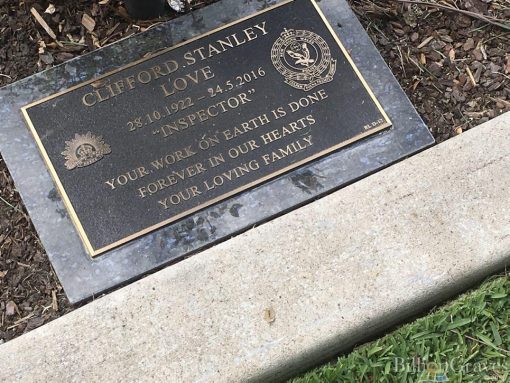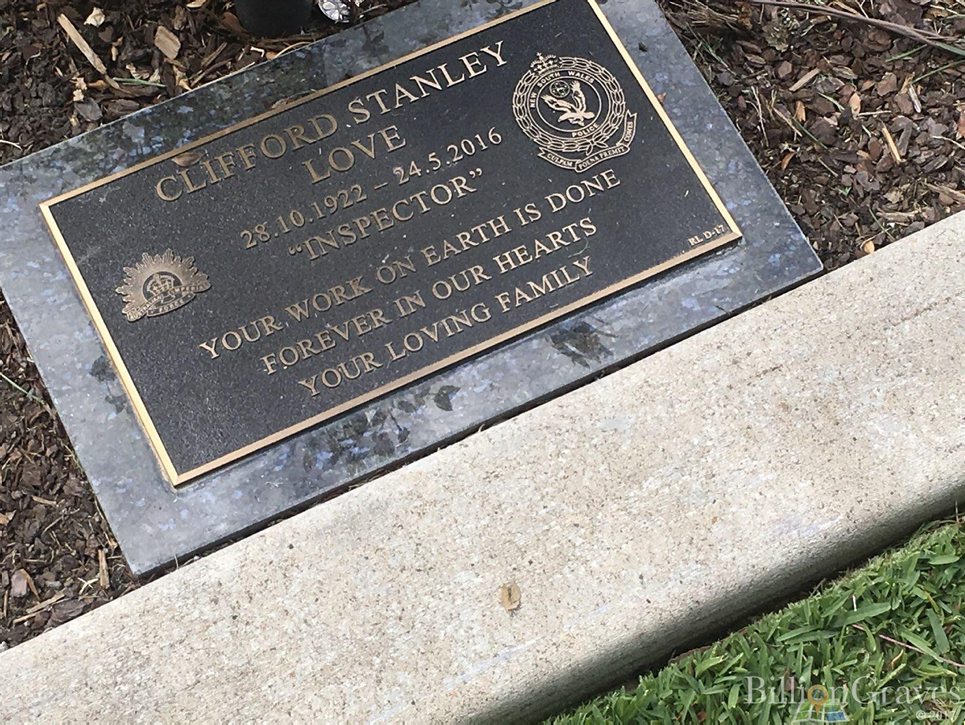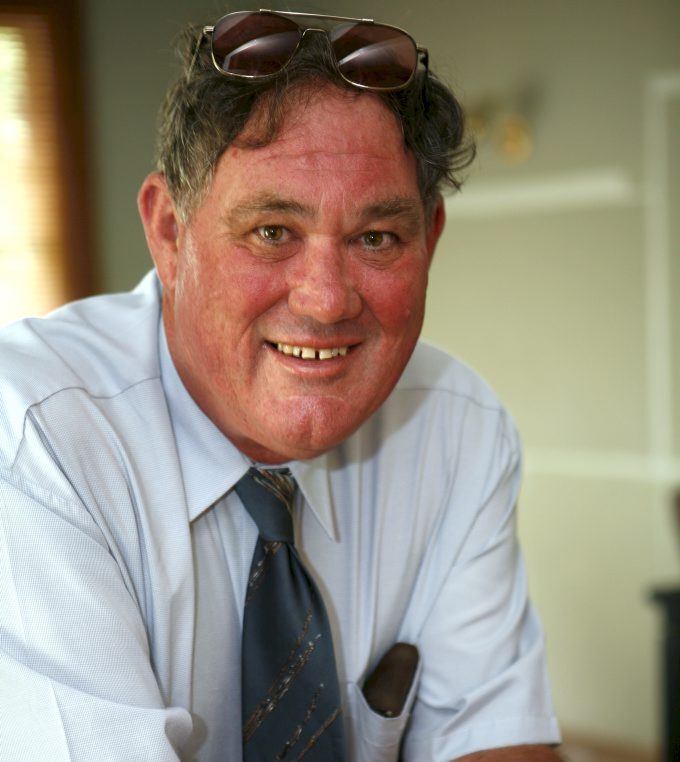Clifford Stanley LOVE
Clifford Stanley LOVE
( late of Warners Bay, NSW )
aka Cliff
NSW Police College, Penrith – Class # 003
New South Wales Police Force
Regd. # 4958
Rank: Probationary Constable – appointed 21 January 1946 ( aged 23 years, 2 months, 24 days )
Sergeant 2/Class – appointed 20 February 1967 ( North East District – Muswellbrook )
Inspector 3rd Class – appointed 31 November 1974
Senior Inspector – appointed 21 December 1978
Stations: ?, Lithgow, Muswellbrook, Newcastle – O.I.C. – retirement
Service: From ? ? 1945 to 27 October 1982 = 36 years Service
Age at Retirement: 59 years, 11 months, 29 days
Time in Retirement: 33 years, 6 months, 27 days
[blockquote]
Australian Imperial Force – ARMY
Regiment: 2/14 Battalion
Enlisted: 17 March 1942 at Paddington, NSW
Service # NX92797
Rank: Private
Embarkation: ?
Next of kin: John LOVE
Religion: ?
Single / Married: ?
Returned to Australia: ?
Date of Discharge: 21 August 1944
[/blockquote]
Awards: No find on It’s An Honour
Born: Saturday 28 October 1922 at Bega, NSW
Died on: Tuesday 24 May 2016
Cause: ?
Age: 93 years, 6 months, 26 days
Funeral date: Monday 30 May 2016 @ 10am
Funeral location: the Chapel of Lake Macquarie Memorial Park Cemetery & Crematorium
Buried at: Lake Macquarie Memorial Park, Palmers Road, Ryhope, NSW

Grave location:
GPS: Approx: -32.992211295758345 151.52122129192654
Memorial at: ?
CLIFF is NOT mentioned on the Police Wall of Remembrance * NOT JOB RELATED
Funeral location: [codepeople-post-map]
FURTHER INFORMATION IS NEEDED ABOUT THIS PERSON, THEIR LIFE, THEIR CAREER AND THEIR DEATH.
PLEASE SEND PHOTOS AND INFORMATION TO Cal
passed away 24th May 2016
Aged 93 Years
‘Inspector First Class,
Officer in Charge, Newcastle District’
(Retired 1982.)
Dearly loved husband of JOYCE.
Much loved father and father in-law-of MAX LOVE & RAE COUGHLAN, MAREE & MICHAEL, COLLEEN & DIAMOND.
Loving Grandfather of MARC & SARAH.
Great Grandfather to HARMONY.
Also a much loved uncle, great uncle, Police colleague and Friend to many.
Relatives and Friends are warmly invited to attend a Celebration of CLIFF’s Life to be held in The Chapel of Lake Macquarie Memorial Park, Palmers Road, Ryhope this MONDAY 30/5/2016 commencing at 10AM.
An interment will follow in the Lawn Cemetery.
Published in The Newcastle Herald from May 27 to May 28, 2016
May you forever Rest In Peace.
Cliff LOVE was the Officer In Charge of the infamous Star Riot in Newcastle on the night of 19 September 1979 when police had to deal with an estimated 4000 rioters when the Star Hotel was closed down.
The Police vehicle Cliff had at the scene was rolled over by the hoodlums and ‘ torched ‘ ( burnt ) at the riots. Paddy Wagons ( Police trucks ) were also rolled and burnt. One officer lost his .38 Smith & Wesson which was later recovered some distance away.
Some of the 40 Police, but not limited to, who attended and were confronted by odds of 100:1 were:
Cliff LOVE
Cliff Judd
Paul Baker
Brian Atkins ( broken wrist )
The night the Star exploded

Twenty-five years after the infamous Newcastle riot, many are still wondering who was to blame, writes John Huxley.
The trouble started just after 10pm when, to scattered cries of “kill the pigs”, an angry, alcohol-fuelled crowd started pouring out of the pub and on to the street to confront a painfully thin blue line of police officers.
Within minutes, missiles were – in the words of one witness – “raining down like rice at a wedding”. Rocks, bottles and beer cans. Watched by several hundred spectators gathered in the middle of the road, the mob rushed police lines and overturned paddy wagons. It was only after two hours of violent mayhem that the crowd was dispersed by fire-brigade hoses. By then, the street had been transformed, says a witness, into a “a sea of rubbish”.
Fourteen officers and eight civilians were on the way to hospital with injuries. Eventually, 46 people were charged with 79 offences, ranging from assault occasioning actual bodily harm to resisting arrest and riotous assembly.
To this day, it is remembered as Newcastle’s “night of infamy”: a Wednesday night, almost exactly 25 years ago, which started much like any other but ended in violent confrontation as about 40 police battled more than 4000 rioters angered by the closure of the Star Hotel in the city’s West End.
As dramatic pictures of the riot flashed round the world, putting the ugly face of Newcastle on front pages of newspapers everywhere, the then NSW premier, Neville Wran, called the events of September 19, 1979, un-Australian. “It was a shocking, disgraceful episode,” he said.
Possibly. But that has not prevented the riot becoming part of Australian folklore. Newcastle City Council produced a lengthy report. The band Cold Chisel recorded a famous song about it (see above). A Hunter Valley theatre group staged a controversial musical about it.
“From this distance it’s easy to lose sight of what really happened, ” Phillip McIntyre, a music writer and lecturer in communications at Newcastle University, explains. “There’s been a lot of myth-making going on.”
Indeed, Cold Chisel frontman Jimmy Barnes recently said people still came up to him to say how f—ing great he was at that gig he played on the last night of the Star. The band never performed at the hotel. Doubts have even been raised about the authenticity of some of the pictures taken that night.
It’s not surprising, then, that a quarter of a century on, the riot remains the subject of controversy. What sparked it? Was it a drunken rabble, a provocative band or heavy-handed police. Or was it the media, who were in place for hours, waiting for something to happen? Was it premeditated or largely spontaneous? And, most importantly, just what was its significance? Nothing more than a shocking show of drunken hooliganism, as Wran put it? Or a political demonstration by an alienated youth triggered into action by the loss of one of the few focuses of community expression?
Like it or not, few would dispute that the Star Hotel was, if not salubrious, then special. Built in 1885 – its distinctive facade dated from 1925 – it was a huge, rambling place stretching a block between King and Hunter streets, and comprising three very different bars and clienteles.
As the National Times newspaper wrote at the time, the front bar “served sailors from around the world, RAAF men, petty criminals and pimps, parachutists and ‘short back and sides’ misfits who didn’t fit into sophisticated taverns”. The middle bar catered for local gays entertained by drag acts, such as that staged by the notorious “Stella the Fella”. And the back bar was where the young people went, where the bands played for free almost every night of the week.
Far from being at each others’ throats, the different groups rubbed along peacefully. “There was a real sense of community, of belonging to the place,” recalls Mark Tinson, of the Heroes, the band playing the last set at the Star on that memorable night.
“Aesthetically though, it was a big toilet. But for the fact I was being paid to perform there, I don’t think I’d have been seen dead in the place.”
Unusually, bands played on a raised stage behind the bar, upon which young girls danced. Often they were semi-naked. Money and $1 cans of beer, dispensed from large ice-filled troughs, were traded across the boozing, cheering crowd.
Most nights, drinkers at the Star could be counted in their hundreds. Estimates of the number of people present on September 19 to drink, to farewell the hotel – peacefully or forcefully – range from 3000 to 8000.
Though only one week’s notice was given to the licensee Don Graham, the writing had been on the Star’s white-brick walls for some time. For the same reasons that patrons loved it – for its rebelliousness, its rowdiness, its unruliness – licensing authorities loathed it. “The Star had a definite reputation,” says McIntyre, with heavy emphasis. A few years earlier, a sailor had been stabbed to death at the hotel. There were regular reports of drugs and of underage drinking. Even Stella the Fella had been given her-his marching orders a few months earlier.
As Tooths Brewery moved to close the Star, its regulars mobilised to defend it. “Save the Star” T-shirts were produced, a petition supported by several thousand names was started, and a group of tradespeople who used the pub even offered their services free to renovate the fallen Star.
“People strongly believed it was ‘their’ pub and they weren’t going to allow anybody take it off them,” McIntyre recalls. Even without the offer of one happy hour’s free beer, the scene was set for an emotional, potentially explosive closing night.
By the time the Heroes started their final number, shortly before the scheduled 10pm shutdown, the crowd had swelled to thousands. Many had been drinking heavily for several hours. “You could feel the electricity in the room,” Tinson says. “But, really, more like a mardi gras or a street party.”
How the party turned into a riot remains unclear. Tinson says the “pivotal moment” occurred shortly before 10pm when police entered the bar and insisted they finish immediately. “I mean we’d 30 seconds to go. And everyone was, well, you’ve got to be kidding.”
In the ensuing chaos, the Heroes stopped playing. There were cries, Tinson says, of “kill the cops, from a couple of idiots”. As the mood turned ugly, the Heroes decided to play their final encore, as they had planned. “I mean we didn’t want to cause a riot.”
Their choice of song, The Star and the Slaughter, led later to singer Peter de Jong being charged with the incitement to riot. One verse runs: “I want action, And I want fighting in the streets. Gonna take this town by storm, Gonna burn the buildings down … ”
Prophetically, the chorus proclaimed, “They will remember the night of the Star and the Slaughter.” Within minutes, the band were interrupted again, Tinson says. “One of the crew came in and said, ‘you should see what’s happening out there’.” The infamous Star Hotel riot had begun.
Tinson, a lifelong teetotaller and still a respected member of the music industry, does not defend the behaviour of the rioters. “They behaved abominably,” he says. And he was reluctant to do or say anything that might prompt people to celebrate – or recreate – the riot. But he insists that by their action, the police inflamed the situation. “I think if they’d given us a few more minutes, the situation could have been avoided,” he says.
He also defends the band’s choice of song which, he insists, did not originally refer to the hotel, had been a regular item on their playlist and had been written many months previously – not, as some critics alleged, earlier that evening. “If only we had that sort of ability.”
For their part, the police, supported by the politicians, insist they had no alternative but to act after the crowd started interfering with traffic and a difficult situation threatened to turn dangerous. Senior officer Cliff Love said at the time that there was no way a force of 40 would choose to confront a crowd of thousands, most of them out of control on alcohol, many of them at least prepared for trouble. “It’s no exaggeration to say that police were in fear for their lives.”
As Mike Scanlon, a Newcastle Herald journalist and historian, recalled, it was also subsequently revealed that authorities were concerned a lost police firearm had been stolen by a rioter. It was later found away from the scene.
Whoever was to blame, whatever the degree of premeditation involved, one thing does appear clear with hindsight: the riot was the product of booze and boredom. More, drunken rabble or not, the rioters – most of them young, many of them unemployed – were representatives of a bigger, nationwide group of boozed, bored people who felt increasingly at odds with the political system.
Over the next few years, similar riots, brawls, battles were to occur across Australia.
As the Newcastle City Council report concluded, across the land there was a “general sense of anger and frustration”.
Life has moved on. Tinson lectures at the local TAFE. He, de Jong and the other Heroes reunited last month to perform at a hospital fund-raiser.
And the Star Hotel, after many incarnations, is scheduled to be demolished to make way for a swish, 12-storey apartment block. Perhaps the old facade will be retained. Perhaps a plaque recording the events of September 19, 1979 will be erected. Perhaps not.
As Tinson says, “The idea of celebrating a riot is a bit off.”
http://www.smh.com.au/articles/2004/09/16/1095320899843.html
The Star Riot
Lithgow Mercury ( NSW )
Friday 22 March 1946 p2
EARLY OFFER TO WINGER
Lithgow this season can easily lose a player to the octupus city clubs before he even appears locally.
He is Constable Cliff Love, who had been posted as a player in the newly formed Diggers‘ team.
Reported to be extra fast, Love, last Sunday was contacted by Sydney Eastern Suburbs officials and asked to appear with them in this week’s trials. Hard on the heels of Easts’ offer came another from Balmain, who will be meeting Easts in this week-end’s series. However, it was a case of first come, first served, and Love will try out with Easts.
If background is anything, Love should be a footballer whom Lithgow will not want to lose. In his younger days, he played school football and was also an athlete of no mean ability, while in later years he appeared with Group 16 on the South Coast prior to his enlistment in the Army, with which he served in New Guinea.
http://trove.nla.gov.au/newspaper/article/219612993
Lithgow Mercury ( NSW ) Wednesday 14 August 1946 p2
Alleged Hit-Run Driver Committed For Trial
Eight police witnesses testified against Henry Lam, of Newtown-street, Alexandria, in Lithgow police court yesterday, when he was committed for trial at Bathurst Quarter Sessions next Tuesday on a charge of having, by a negligent act – driving a motor vehicle negligently – caused grievous bodily harm to Const. Clifford Stanley Love on the night of July 20.
Mr. J. S. Hart, P.M, was on the Bench. The charge was a sequel to an alleged hit-run accident several weeks ago when Const. Love was struck by a car and thrown against an ambulance when investigating an accident in which Mr. Harry Earp, of McKellar’s Paddock, had been injured by another car.
After the accident, said Det. Sgt. E. E. Mabbutt in evidence, he went to Church-street and saw an “A” Model Ford in front of George Corney’s residence. He had a conversation with Corney, examined the car and with Corney took the vehicle to the police station, where it was subsequently photographed. The near side mudguard had a slight dent.
Witness continued that on July 25, accompanied by Det. Armstrong, of Redfern police, he saw the defendant at his home and had a conversation with him.
In respect to the accident and injuries sustained by Constable Love, Lam, he alleged, said he was very sorry to hear that the Constable had been Injured.
Det. Sgt. Mabbutt stated that the defendant admitted that he had been in Lithgow on the Saturday and had left for Sydney on the 6.30 p.m. train and that prior to his departure he had had an arrangement with George Corney to use a car, owned by a man named Purcell, for the purpose of driving to Littleton to pick up his port at his sister’s place.
ADMITTED SWERVING
Lam, he added, also admitted that he had seen an ambulance in Main-street east and had swerved to the right to avoid a collision. He denied having seen the light in the rear of the ambulance or having seen a Constable standing nearby.
When told that the crowd in Main-street had became hostile after he struck the Constable and called out, “stop, you have hit someone,” Lam said he had not felt a bump, nor did he hear any one call out. Lam, added the witness, said he had not been licenced to drive at the time of the accident.
Det. Sgt. Mabbutt then exhibited an overcoat, which, it was claimed, had been worn by Const. Love on the night of July 20. It was torn in several places and streaked with duco. An envelope containing strips of duco taken from the mudguard of the car was also tendered.
VISIBILITY BAD
In reply to Mr. Ian L. Higgins, witness said that at the time of the accident the night was damp and visibility was bad. He said he did not know Lam had been a transport driver in the R.A.A.F. or that he was on discharge leave when the accident occurred.
George Burgess, a miner, said he was the driver of a car which had collided with a pedestrian about 50 yards west of the Court House Hotel corner. He was standing near the ambulance when he heard Superintendent Purdie ( A. Purdie, NSW Ambulance ), or someone call out a warning. He moved towards the Superintendent, heard a terrific bump and saw Const. Love knocked by a car. Love struck the ambulance door and fell to the ground. He helped him to his feet and saw a car turning Bridge-street comer an increasing speed.
Just as he was stepping from the ambulance, after having placed an Injured pedestrian inside, Const. Love spoke to him about the accident and at the same moment was struck by the mudguard of a car, said Superintendent A. Purdie.
UNSUCCESSFUL CHASE
He told the Constable to get into the front of the ambulance and they would try to catch the car. They were unsuccessful and he took Love to the hospital, where five stitches were inserted in his head wounds.
Alexander John Jenkins, a bus driver, stated that he was standing near the bus stop on the northern side of Main-street and saw the car which it was alleged had struck Const. Love. He knew the vehicle well because he had sold it a few days before.
Evidence was given by Athol Joseph Rigg, a grocer, that he was standing near Leighton’s tailor shop when he noticed a car approaching from the west. Before it reached the ambulance it swerved to the right, hit the open door of the ambulance and caught Const. Love. The car kept going and passed between the vehicle involved in the first accident, which was in the centre of the road, and the footpath near the Court House Hotel. It cut the corner and went up Bridge-street.
George Corney, garage proprietor, said he allowed Lam, who was well known to him, to use the car to assist him to catch the 6.30 p.m. train. He did not know the car had been returned to his home until Sgt. Mabbutt questioned him. When he examined the vehicle he noticed a slight dent on the near side mudguard.
DID NOT REMEMBER MUCH
Victim of the accident, Const. Clifford Stanley Love, told the police prosecutor ( Sgt. H. Taylor ) that he did not remember much after being hit. He added he had suffered much pain as a result of head and hip injuries, which had resulted in him being off duty for several weeks.
A description of Love’s injuries was given by Dr. Geoffrey Athol Williams, R.M.O., Lithgow hospital.
Mr. Higgins, who asked the Bench to dismiss the charge, said there was no evidence of criminal negligence. It could not be shown in the evidence that the defendant had planned to cause an accident, nor that he had deliberately committed the act.
Mr. Hart said he was satisfied that there was sufficient evidence to support a charge of negligent driving and committed the defendant for trial. Bail of £50 was allowed. Lam declined to make a statement and reserved his defence.
On two charges of failing to stop after an accident and driving without a licence Lam was remanded until September 29 on £20 bail. He was discharged on a third count of causing bodily harm by wanton driving.
http://trove.nla.gov.au/newspaper/article/219621273
National Advocate ( Bathurst NSW )
Thursday 22 August 1946 p4
DRIVING CHARGE FAILS
Lithgow Man Acquited at Bathurst
Henry Lamb, of Lithgow, recently discharged from the RAAF, was also discharged by Judge Shortland at Bathurst Quarter sessions yesterday.
Lamb was charged with driving a motor vehicle upon a public street, negligently, whereby he caused Constable Clifford Stanley Love bodily harm.
After hearing evidence, his Honor directed the jury to acquit Lamb. Judge Shortland pointed out that it would be necessary to prove criminal negligence on the part of Lamb and it did not appear that such evidence was forthcoming. Under another section of the Act, a case might have been made out, but under the section by which Lamb was charged a definition – not so far made – was necessary if the court was to be clear on the matter.
Evidence heard was to the effect, that Lamb had been driving a car along Main Street, Lithgow, on the night of July 20, and had hit Constable Love when Love was standing at the rear of an ambulance car. An accident had occurred a short time before Lamb drove along the street. The ambulance was parked in the street with all lights on, an injured person was receiving attention, visibility was bad, and there were buses parked near the scene of the accident, and a crowd had gathered in the street.
Lamb’s defence was that he did not see the ambulance car until almost upon it and swerved to avoid it. He was not aware, however, that he had hit the constable.
http://trove.nla.gov.au/newspaper/article/161327371
Lithgow Mercury ( NSW )
Wednesday 19 November 1947 p5
LITHGOW WEDDING
LOVE – TRIPLETT
St. Paul’s Church of England was, on Saturday, November 8, the scene of a pretty wedding, the parties being Joyce Isobelle Triplett, youngest daughter of Mrs. C. Triplett and the late C. Triplett, of Read Avenue, and Clifford Stanley Love, youngest son of Mr. and Mrs. F. T. Love, of Bega. Rev. A. E. Begbie officiated.
The bride, who was given away by her brother, Mr. E. R. Triplett, was gowned in French Chantilly lace over taffeta, cut with sweetheart neckline and trained hem. Her veil of billowy tulle was surmounted by a coronet of white flowers. The bridal bouquet was of roses, sweet-peas and lily of the valley. The matron of honor was Mrs. A. N. Thomas, of Wallangarra, the bride’s sister. She wore heaven-blue crepe with matching straw hat veiled with stiffened net. She carried a bouquet of crimson roses.
Mr. B. Schonbeck was best man.
Many guests were received at Bolt’s Hall by the bride’s mother, who wore a pastel pink frock with navy accessories and a shoulder spray of roses. The bridegroom’s sister, Mrs. H. Lush of Sydney, who was acting in the absence of his parents, wore a suit of navy and white silk jersey, with white accessories and shoulder spray of red roses.
The chairman, Rev. A. .E.. Begbie, rendered a solo, “Passing By.” The wedding cake was made by the bride’s mother and decorated by Mr. W, Smith.
The happy couple left for Sydney, the bride travelling in a suit of turquoise blue crepe, with black accessories. The honeymoon is being spent at Surfer’s Paradise and Bega.
Mr. and Mrs. Love will make their home in Lithgow.
http://trove.nla.gov.au/newspaper/article/22075844
Lithgow Mercury ( NSW )
Monday 17 April 1950 p2
BREVITIES
Following annual leave spent at Bega, on the South Coast, Constable G. Love resumed duty at the Lithgow police station this morning.
http://trove.nla.gov.au/newspaper/article/219761445


